check engine PONTIAC PONTIAC 1997 Owner's Guide
[x] Cancel search | Manufacturer: PONTIAC, Model Year: 1997, Model line: PONTIAC, Model: PONTIAC PONTIAC 1997Pages: 419, PDF Size: 19.67 MB
Page 289 of 419
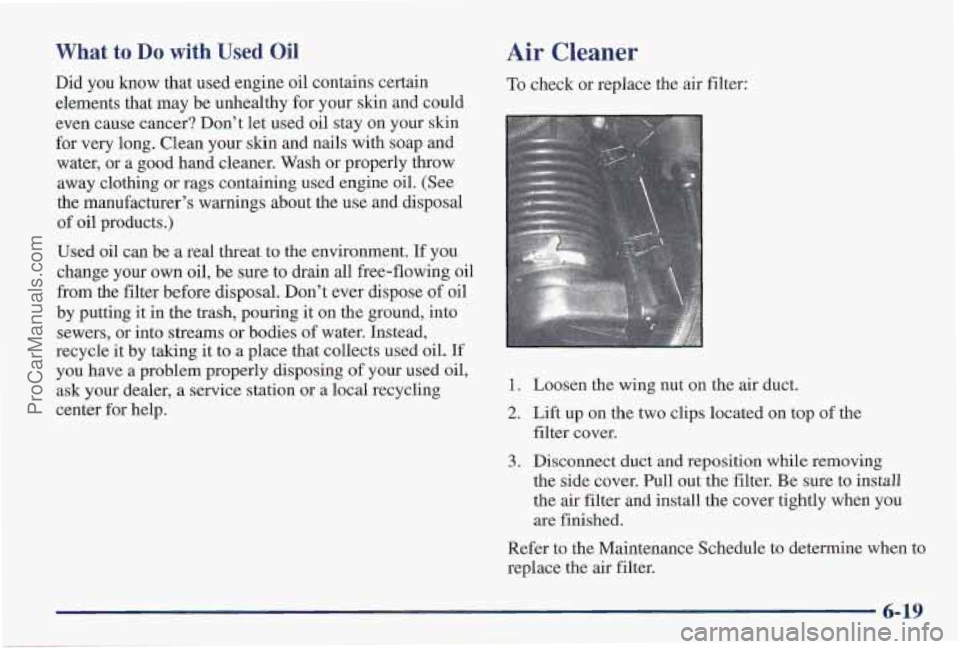
What to Do with Used Oil
Did you know that used engine oil contains certain
elements that may be unhealthy for your skin and could
even cause cancer? Don't let used oil stay on your skin
for very long. Clean your skin and nails with soap and
water, or a good hand cleaner. Wash or properly throw
away clothing
or rags containing used engine oil. (See
the manufacturer's warnings about the use and disposal
of oil products.)
Used oil can be
a real threat to the environment. If you
change your own oil, be sure to drain all free-flowing oil
from the filter before disposal. Don't ever dispose of oil
by putting it in the trash, pouring it on the ground, into
sewers, or into streams or bodies of water. Instead,
recycle it by taking it to a place that collects used oil. If
you have a problem properly disposing
of your used oil,
ask your dealer,
a service station or a local recycling
center for help.
Air Cleaner
To check or replace the air filter:
1.
2.
3.
Loosen the wing nut on the air duct.
Lift up on the two clips located on top of the
filter cover.
Disconnect duct and reposition while removing
the side cover. Pull out the filter.
Be sure to install
the air filter and install the cover tightly when you
are finished.
Refer
to the Maintenance Schedule to determine when to
replace the air filter.
ProCarManuals.com
Page 290 of 419
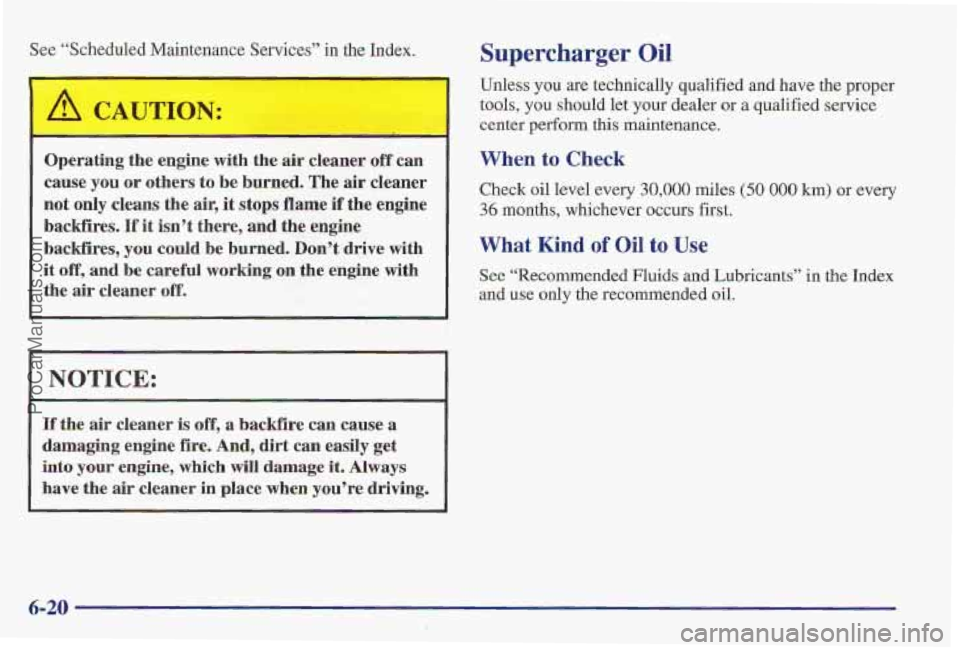
See “Sche 1 M ltenance Services” in the In’dex, ..
-
Operating the engine with the air cleaner off can
cause
you or others to be burned. The air cleaner
not only
cleans the air, it stops flame if the engine
backfires.
If it isn’t there, and the engine
backfires, you
could be burned. Don’t drive with
it
off, and be careful working on the engine with
the air cleaner
off.
NOTICE:
If the air cleaner is off, a backflre can cause a
damaging engine fire. And, dirt can easily get
into
your engine, which will damage it. Always
have the air cleaner in place when you’re driving.
Supercharger Oil
Unless you are technically qualified and have the proper
tools,
you should let your dealer or a qualified service
center
perform this maintenance.
When to Check
Check oil level every 30,000 miles (50 000 km) or every
36 months, whichever occurs first.
What Kind of Oil to Use
See “Recommended Fluids and Lubricants” in the Index
and use only the recommende’d oil.
6-20
ProCarManuals.com
Page 291 of 419

How to Check and Add Oil
Check oil only when the engine is cold. Allow the
engine to cool two to three hours after running.
If you remove the supercharger oil fill plug while
the engine is hot, pressure may cause hot oil to
blow out
of the oil fill hole. You may be burned.
DQ not remove the plug until the engine cools.
1. Clean the area around the oil fill plug before
removing it.
2, Remove the oil fill plug using a 3/16 inch
Allen wrench.
5. The oil level is correct when it just reaches the
bottom of the threads
of the inspection hole.
4. Replace the oil plug with the O-ring in place.
Torque to 88
lb-in (10 N.m).
Automatic Transaxle Fluid
When to Check and Change
A good time to check your automatic transaxle fluid
level is when the engine oil is changed.
Change both the fluid and filter every
50,000 miles
(83
000 km) if the vehicle is mainly driven under one or
more of these conditions:
In heavy city traffic where the outside temperature
regularly reaches
90 OF (3 2 O C) or higher.
0 In hilly or mountainous terrain.
0 When doing frequent trailer towing.
Uses such as found in taxi, police or delivery service.
If you do not use your vehicle under any of these
conditions, the fluid and filter do not require changing.
See “Scheduled Maintenance Services” in the Index.
ProCarManuals.com
Page 292 of 419

How to Check
Because this operation can be a little difficult, you may
choose to have this done at your Pontiac dealership
Service Department.
If you do it yourself, be sure to follow all the
instructions here, or you could get
a false reading
on the dipstick.
NOTICE:
Too much or too little fluid can damage your
transaxle. Too much can mean that some of the
fluid could come out and fall on hot engine parts
or exhaust
system parts, starting a fire. Be sure to
get
an accurate reading if you check your
transaxle
fluid,
Wait at least 30 minutes before checking the transaxle
fluid level if you have been driving:
When outside temperatures are above 90°F (32°C).
0 At high speed for quite a while.
In heavy traffic -- especially in hot weather.
0 While pulling a trailer.
To get the right reading, the fluid should be at norrnal
operating temperature, which is
1801°F to 200°F
(82°C to 93°C).
Get the vehicle warmed up by driving about 15 miles
(24 km) when outside temperatures are above 50°F
( lo°C). If it's colder than 50" F ( lO"C), you may have
to drive longer.
6-22
ProCarManuals.com
Page 293 of 419

Checking the Fluid Level
Park your vehicle on a level place. Keep the engine
0 With the parking brake applied, place the shift lever
With your foot on the brake pedal, move the shift
running.
in
PARK (P).
lever through each gear range, pausing for about
three seconds in each range. Then, position the shift
lever in
PARK (P).
0 Let the engine run at idle for three to five minutes. Then, without shutting
off the
engine, follow these steps:
3100 Engine
The transaxle fluid dipstick
handle is
the red loop near
the back of the engine.
ProCarManuals.com
Page 295 of 419
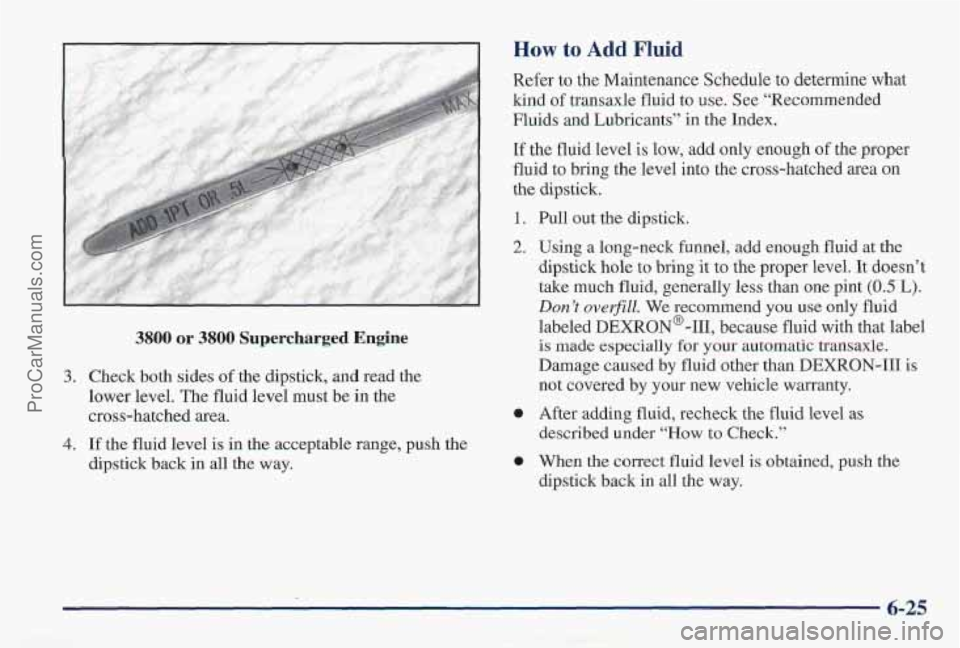
How to Add Fluid
3.
4.
3800 or 3800 Supercharged Engine
Check both sides of the dipstick, and read the
lower level. The fluid level must
be in the
cross-hatched area.
If the fluid level is in the acceptable range, push the
dipstick back in
all the way. Refer
to the Maintenance Schedule to determine what
kind
of transaxle fluid to use. See “Recommended
Fluids and Lubricants” in the Index.
If the fluid level
is low, add only enough of the proper
fluid to bring the level into the cross-hatched area on
the dipstick.
1. Pull out the dipstick.
2. Using a long-neck funnel, add enough fluid at the
dipstick hole to bring it to the proper level.
It doesn’t
take much fluid, generally less than one pint
(0.5 L).
Don’t overfill. We recommend you use only fluid
labeled DEXR0N’-111, because fluid with that label
is made especially for your automatic transaxle.
Damage caused by fluid other than
DEXRON-I11 is
not covered
by your new vehicle warranty.
0 After adding fluid, recheck the fluid level as
described under
“How to Check.”
0 When the correct fluid level is obtained, push the
dipstick back in all the way.
6-25
ProCarManuals.com
Page 297 of 419
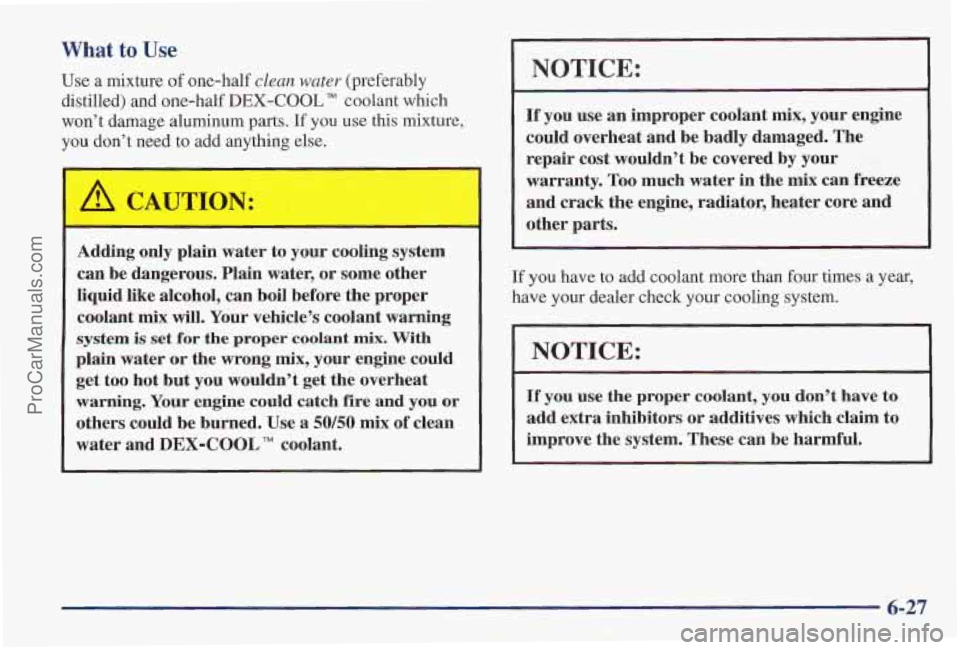
What to Use
Use a mixture of one-half clean water (preferably
distilled) and one-half
DEX-COOL TM coolant which
won’t damage aluminum parts.
If you use this mixture,
you don’t need to add anything else.
Adding only plain water to your cooling system can be dangerous. Plain water, or some other
liquid like alcohol, can boil before the proper
coolant mix will. Your vehicle’s coolant warning
system
is set for the proper coolant mix. With
plain water or the wrong mix, your engine could
get too hot but you wouldn’t get the overheat
warning. Your engine could catch fire and you or
others could be burned. Use
a 50/50 mix of clean
water and
DEX-COOL TM coolant.
NOTICE:
If you use an improper coolant mix, your engine
could overheat and be badly damaged. The
repair cost wouldn’t be covered by your
warranty.
Too much water in the mix can freeze
and crack the engine, radiator, heater core and
other parts.
If you have to add coolant more than four times a year,
have your dealer check your cooling system.
~~
NOTICE:
If you use the proper coolant, you don’t have to
add extra inhibitors or additives which claim to
improve the system. These can be harmful.
6-27
ProCarManuals.com
Page 298 of 419
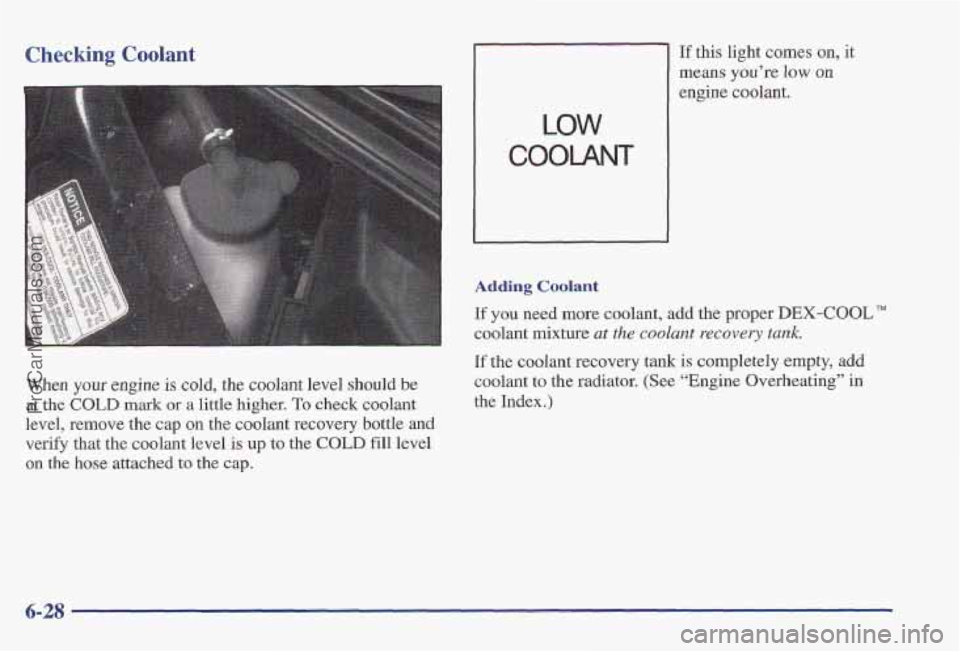
Checking Coolant
When your engine is cold, the coolant level should be
at the COLD mark or a little higher. To check coolant
level, remove the cap on the coolant recovery bottle and
verify that
the coolant level is up to the COLD fill level
on the hose attached to the cap.
LOW
COOLANT
If this light comes on, it
means
you’re low on
engine coolant.
Adding Coolant
If you need more coolant, add the proper DEX-COOL”
coolant mixture at the mulant recovery tank.
If the coolant recovery tank is completely empty, add
coolant
to the radiator. (See “Engine Overheating” in
the
Index.)
6-28
ProCarManuals.com
Page 300 of 419

Power Steering Fluid
3100 Engine 3800 or 3800 Supercharged Engine
When to Check Power Steering Fluid
It is not necessary to regularly check power steering
fluid unless
you suspect there is a leak in the system or
you hear an unusual noise. A fluid loss in this system
could indicate
a problem. Have the system inspected
and repaired.
6-30
ProCarManuals.com
Page 301 of 419

How To Check Power Steering Fluid
When the engine compartment is cool, unscrew the cap
and wipe the dipstick with
a clean rag. Replace the cap
and completely tighten it. Then remove the cap again
and look at the fluid level on the dipstick.
3100 Engine
When the engine
compartment
is hot, the
level should be at the
H or
HOT mark. When it’s cold,
the le.vel should be at the
C or COLD mark. If the
fluid
is at the ADD mark,
you should add fluid. 3800 or 3800 Supercharged Engine
What to Use
Refer to the Maintenance Schedule to determine what
kind
of fluid to use. See “Recommended Fluids and
Lubricants” in the Index. Always use the proper fluid.
Failure to use the
proper fluid can cause leaks and
damage hoses and seals.
6-3 1
ProCarManuals.com